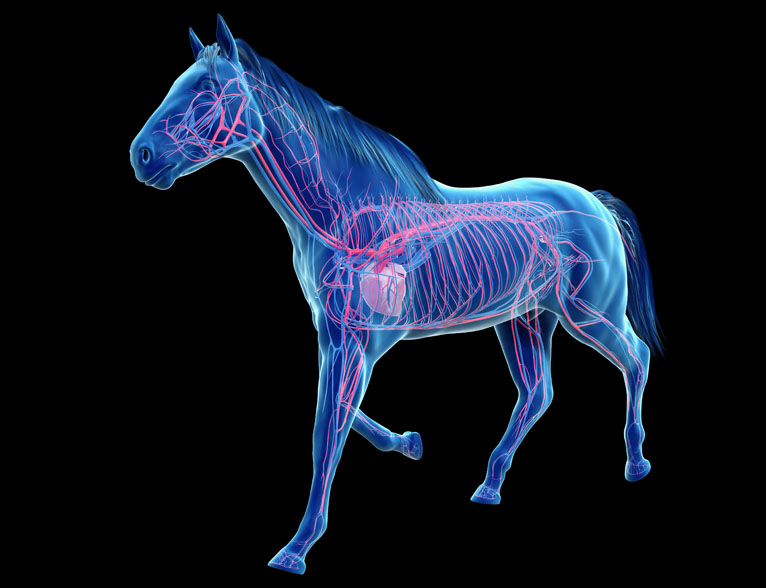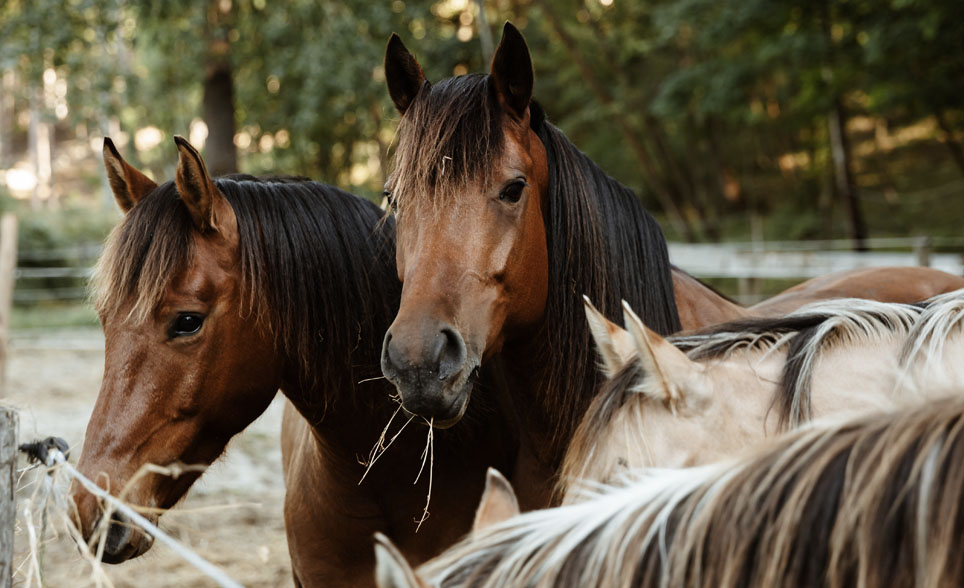Living outside year round, with no "clothes" on...

Through living outside year round, horses have developed an extremely efficient thermoregulatory system in their skin. It is through the skin that the horse gains information about the environment. But for it to work properly they need to have constant access to that environment which is why horses are healthier living outside year round.
Each individual hair in a horse's coat has a small muscle attached to it. This enables the horse to raise and lower the hairs to change the thickness of the coat. When the horse is cold it will raise the hairs so they can trap a layer of warm air. The air is warmed by the heat loss from the horse's skin and the hairs prevent the air from escaping. As the horse warms up the coat will be flattened. This in turn decreases the amount of insulation and varies the amount of airflow to the skin.
Just like any other muscle the hair muscles need to be exercised to perform properly. When a horse is kept in a stable in a fairly constant temperature with a blanket on, the muscles do not get exercised. This impacts on the horse when the blanket is taken off when going for a ride. Suddenly the horse is subjected to much lower temperatures and it's muscles aren't able to respond effectively.
When a blanket is put on the horse the hairs are forced to lie flat. This means that the horse no longer has control over regulating it's temperature. Often the horse gets too hot under the rug and it is helpless to do anything about it. However the uncovered parts of the horse still get cold so the horse tries to warm them up which in turn make the areas under the rug even hotter. If the horse starts sweating under the blanket it lowers the temperature too much as the moisture is trapped and the horse's system will suffer. As a result the chemical processes within the horse may be partially disabled which will allow diseases such as colds and flu to take a hold.
Blanketing and stabling a horse prevents the horse from growing a thicker coat in the winter. Also too much grooming can strip the coat of its natural greases which are there to keep it waterproofed. So try to avoid over grooming in the winter and keep bathing to a minimum.

Horses generate most of their heat through the process of digestion, so increasing their roughage intake during cold weather is the best way to ensure they stay warm.
They can also generate heat through muscle action when moving. This
is another good reason for horses to be living outside year round so
they have space to move around. Short term shivering can also be utilized to generate heat
through muscle use.
Adaptations Enable Living Outside Year Round
Horses have adapted, through living outside year round, to deal with colder conditions. It is much easier for them to warm up than to cool down. Unlike a dog, a horse cannot use panting to lower it's temperature. It relies mainly on sweating. The sweat glands secrete fluid which cools the skin surface as it evaporates. The sweaty horse will raise the hairs in it's coat and turn them in different directions to allow the air to dry the sweat. In a stable there is very little airflow so the sweat takes longer to dry which can lead to chilling.
There are times when I will temporarily blanket a horse and that is when there are prolonged periods of cold rain and wind. For very young or old horses, or those with compromised immune systems I find that they appreciate a chance to dry off and so I during those times I will put a cooler underneath a rain sheet to allow them to dry off. Then once they are dry and the weather has improved I will take the rain sheet back off again.
Can I ride an unclipped horse in the winter?
When you clip a horse you are robbing it of it's mechanism for keeping warm. It can no longer raise the hairs to create insulation in the clipped areas, which mean that they will always remain colder than the rest of the unclipped body. If a rug is then also added the horse ends up with double insulation in some places and no insulation in others. It is therefore much kinder to leave the horse unclipped and unrugged. If your horse gets sweaty when ridden then it has the mechanisms in place to deal with it. Once the horse gets turned out it will raise it's hairs in varying directions to allow air to dry the sweat.
Should I put a sweat rug/cooler on my horse?
A sweat rug flattens the hairs against the body which prevents the sweat from evaporating. If you put horse in a stable you are limiting the airflow so the horse will take even longer to dry. So it is best to leave nature to take care of it by simply turning the horse out in the field. You can give your horse a head start by always coming back to a walk for the last half mile home on a ride. This will allow the horse time to cool down and the sweat to begin to dry
If your horse is really wet, then an alternative is to add a layer of straw beneath the cooler. This allows the hairs to elevate as well as increases the airflow and the heat from the horse's body will warm up the air and dry the coat quicker.